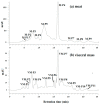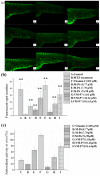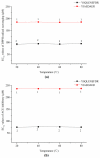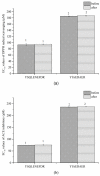Two Novel Multi-Functional Peptides from Meat and Visceral Mass of Marine Snail Neptunea arthritica cumingii and Their Activities In Vitro and In Vivo
- PMID: 30486436
- PMCID: PMC6315844
- DOI: 10.3390/md16120473
Two Novel Multi-Functional Peptides from Meat and Visceral Mass of Marine Snail Neptunea arthritica cumingii and Their Activities In Vitro and In Vivo
Abstract
Neptunea arthritica cumingii (Nac) is a marine snail with high nutritional and commercial value; however, little is known about its active peptides. In this study, two multi-functional peptides, YSQLENEFDR (Tyr-Ser-Gln-Leu-Glu-Asn-Glu-Phe-Asp-Arg) and YIAEDAER (Tyr-Ile-Ala-Glu-Asp-Ala-Glu-Arg), were isolated and purified from meat and visceral mass extracts of Nac using a multi-bioassay-guided method and were characterized by using liquid chromatography-tandem mass spectrometry. Both peptides showed high antioxidant, angiotensin-converting enzyme (ACE)-inhibitory, and anti-diabetic activities, with half-maximal effective concentrations values less than 1 mM. Antioxidant and ACE-inhibitory activities were significantly higher for YSQLENEFDR than for YIAEDAER. In a zebrafish model, the two peptides exhibited strong scavenging ability for reactive oxygen species and effectively protected skin cells against oxidative damage without toxicity. Molecular docking simulation further predicted the interactions of the two peptides and ACE. Stability analysis study indicated that the two synthetic peptides maintained their activities under thermal stress and simulated gastrointestinal digestion conditions. The low molecular weight, high proportion of hydrophobic and negatively-charged amino acids, and specific C-terminal and N-terminal amino acids may contribute to the observed bio-activities of these two peptides with potential application for the prevention of chronic noncommunicable diseases.
Keywords: ACE-inhibitory activity; Neptunea arthritica cumingii; anti-diabetic activity; antioxidant activity; multi-functional peptides.
Conflict of interest statement
The authors declare no conflict of interest.
Figures








Similar articles
-
Preparation and Identification of ACE Inhibitory Peptides from the Marine Macroalga Ulva intestinalis.Mar Drugs. 2019 Mar 19;17(3):179. doi: 10.3390/md17030179. Mar Drugs. 2019. PMID: 30893907 Free PMC article.
-
Identification of Structure-Linked Activity on Bioactive Peptides from Sea Cucumber (Stichopus japonicus): A Compressive In Silico/In Vitro Study.Front Biosci (Landmark Ed). 2024 Oct 23;29(10):368. doi: 10.31083/j.fbl2910368. Front Biosci (Landmark Ed). 2024. PMID: 39473427
-
Two novel peptides with angiotensin I converting enzyme inhibitory and antioxidative activities from Scorpaena notata muscle protein hydrolysate.Biotechnol Appl Biochem. 2017 Mar;64(2):201-210. doi: 10.1002/bab.1478. Epub 2016 Jun 16. Biotechnol Appl Biochem. 2017. PMID: 26799603
-
Plant food-derived Angiotensin I converting enzyme inhibitory peptides.J Agric Food Chem. 2009 Jun 24;57(12):5113-20. doi: 10.1021/jf900494d. J Agric Food Chem. 2009. PMID: 19449887 Review.
-
From Sea to Lab: Angiotensin I-Converting Enzyme Inhibition by Marine Peptides-Mechanisms and Applications.Mar Drugs. 2024 Sep 30;22(10):449. doi: 10.3390/md22100449. Mar Drugs. 2024. PMID: 39452857 Free PMC article. Review.
Cited by
-
The Peptide LLTRAGL Derived from Rapana venosa Exerts Protective Effect against Inflammatory Bowel Disease in Zebrafish Model by Regulating Multi-Pathways.Mar Drugs. 2024 Feb 22;22(3):100. doi: 10.3390/md22030100. Mar Drugs. 2024. PMID: 38535441 Free PMC article.
-
Occurrence and Identification of Pathogenic Vibrio Contaminants in Common Seafood Available in a Chinese Traditional Market in Qingdao, Shandong Province.Front Microbiol. 2020 Jun 30;11:1488. doi: 10.3389/fmicb.2020.01488. eCollection 2020. Front Microbiol. 2020. PMID: 32695094 Free PMC article.
-
Study on the Mechanism of the Danggui-Chuanxiong Herb Pair on Treating Thrombus through Network Pharmacology and Zebrafish Models.ACS Omega. 2021 May 25;6(22):14677-14691. doi: 10.1021/acsomega.1c01847. eCollection 2021 Jun 8. ACS Omega. 2021. PMID: 34124490 Free PMC article.
-
Antiaging Potential of Peptides from Underused Marine Bioresources.Mar Drugs. 2021 Sep 10;19(9):513. doi: 10.3390/md19090513. Mar Drugs. 2021. PMID: 34564175 Free PMC article. Review.
-
Peptide GTSFTTTAER From Rapana venosa Alleviates TNBS-Induced Inflammatory Bowel Disease in a Zebrafish Model via Multi-Pathway Regulation.Food Sci Nutr. 2025 Jun 12;13(6):e70427. doi: 10.1002/fsn3.70427. eCollection 2025 Jun. Food Sci Nutr. 2025. PMID: 40521083 Free PMC article.
References
MeSH terms
Substances
Grants and funding
LinkOut - more resources
Full Text Sources
Other Literature Sources
Medical
Molecular Biology Databases
Research Materials
Miscellaneous

